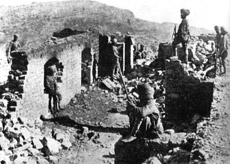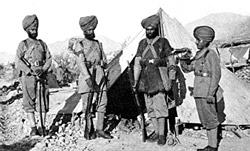 The Battle of Saragarhi was fought during the Tirah Campaign on 12 September 1897. The opponents were twenty-one Sikhs of the 4th Battalion (then 36th Sikhs) of the Sikh Regiment of British India, defending an army post, on one side and 10,000 Afghan and Orakzais tribesmen on the other side. The battle took place in the North West Frontier Province, at present a part of Pakistan, which then constituted a section of British India. The battle has been ranked as a noteworthy instance of exceptional bravery. UNESCO has depicted the Battle of Saragarhi as one of eight legends of joint bravery.
The Battle of Saragarhi was fought during the Tirah Campaign on 12 September 1897. The opponents were twenty-one Sikhs of the 4th Battalion (then 36th Sikhs) of the Sikh Regiment of British India, defending an army post, on one side and 10,000 Afghan and Orakzais tribesmen on the other side. The battle took place in the North West Frontier Province, at present a part of Pakistan, which then constituted a section of British India. The battle has been ranked as a noteworthy instance of exceptional bravery. UNESCO has depicted the Battle of Saragarhi as one of eight legends of joint bravery.
With the purpose of strengthening their position and controlling the insurgent and hostile activities of some of the local tribal groups residing in the north western frontiers of undivided India, the British rulers of India had built a number of forts in the North West Frontier Province (NWFP), then a part of India but now under Pakistan. Fort Lockhart and Fort Gulistan, a few kilometres away from each other, are examples of two such forts. They were positioned on the Samana ridge of the Hindukush and Sulaiman ranges. As the two forts could not be seen from one another, a properly veiled signalling post named Saragarhi was formed to assist in heliographic interactions between the two forts. In 1897, the year when the Battle of Saragarhi was fought, rebellious and hostile activities had increased, and on the 3rd and the 9th of September Afridi tribes, commited to the Afghans, attacked Fort Gulistan. Both the attacks were counteracted. Moreover, the strength of the signalling post at Saragarhi was reinforced to one non commissioned Officer (NCO) and twenty troops of Other Ranks.
 On the 12th of September 1897, the troops of Orakazai and Afridi tribes, prompted by the Afghans, launched fresh attacks and laid a siege on Fort Lockhart and Saragarhi. The force cumulatively amounted to of 12000 to 14000 armed tribesmen. The tribesmen made several offers to the Sikh troops to surrender. But the Sikhs ignored all their offers and resolved to continue fighting and hence began the famous Battle of Saragarhi. The fierce fighting went on for a long time. While the enemy was suffering losses, the number of the defenders as well as the stock of ammunition was also decreasing. At the time when the battle was going on, Sepoy Gurumukh Singh was flashing every detail of the battle through heliographic signals. In the meantime, the enemy set the area enclosing Saragarhi on fire. Two of them managed to break into the wall of the signaling post. In the concluding phases of the battle, hand to hand fighting took place. When the enemy came too close, Sepoy Gurumukh Singh closed the heliograph took out his rifle and plunged upon the enemies. He killed 20 of them, before succumbing to his injuries. Every defender of Saragarhi had laid down his life in an exceptional show of bravery. Relief reached the post, but only on the next day. However, the enemy lost 180 men and many more wounded. When the valor of Saragarhi was narrated to the Parliament of the United Kingdom, the narration drew a standing applause from the members. Queen Victoria also became aware of the legend of Saragarhi. It was declared in the British Parliament "The British, as well as the Indians, are proud of the 36th Sikh Regiments. It is no exaggeration to record that the armies which possess the valiant Sikhs cannot face defeat in war".
On the 12th of September 1897, the troops of Orakazai and Afridi tribes, prompted by the Afghans, launched fresh attacks and laid a siege on Fort Lockhart and Saragarhi. The force cumulatively amounted to of 12000 to 14000 armed tribesmen. The tribesmen made several offers to the Sikh troops to surrender. But the Sikhs ignored all their offers and resolved to continue fighting and hence began the famous Battle of Saragarhi. The fierce fighting went on for a long time. While the enemy was suffering losses, the number of the defenders as well as the stock of ammunition was also decreasing. At the time when the battle was going on, Sepoy Gurumukh Singh was flashing every detail of the battle through heliographic signals. In the meantime, the enemy set the area enclosing Saragarhi on fire. Two of them managed to break into the wall of the signaling post. In the concluding phases of the battle, hand to hand fighting took place. When the enemy came too close, Sepoy Gurumukh Singh closed the heliograph took out his rifle and plunged upon the enemies. He killed 20 of them, before succumbing to his injuries. Every defender of Saragarhi had laid down his life in an exceptional show of bravery. Relief reached the post, but only on the next day. However, the enemy lost 180 men and many more wounded. When the valor of Saragarhi was narrated to the Parliament of the United Kingdom, the narration drew a standing applause from the members. Queen Victoria also became aware of the legend of Saragarhi. It was declared in the British Parliament "The British, as well as the Indians, are proud of the 36th Sikh Regiments. It is no exaggeration to record that the armies which possess the valiant Sikhs cannot face defeat in war".
All the 21 Sikh non-commissioned officers and soldiers of other ranks who bravely faced death in the Battle of Saragarhi were posthumously honoured by being awarded the Indian Order of Merit, the highest gallantry award of that time, which an Indian soldier, if alive, could receive in person from the British crown. The names of the 21 recipients of the gallantry award are Sepoy Uttar Singh, Sepoy Bhola Singh, Sepoy Narayan Singh, Sepoy Gurmukh Singh, Lance Naik Chanda Singh, Havildar Ishar Singh, Sepoy Ram Singh, Sepoy Jivan Singh, Sepoy Sahib Singh, Sepoy Gurmukh Singh, Sepoy Bhagwan Singh, Sepoy Hira Singh, Sepoy Ram Singh, Naik Lal Singh, Sepoy Daya Singh, Sepoy Sundar Singh, Sepoy Jivan Singh, Sepoy Buta Singh, Sepoy Bhagwan Singh, Sepoy Nand Singh and Sepoy Jivan Singh.
The modern Sikh Regiment even now celebrates the day of the Battle of Saragarhi each 12th September as the Regimental Battle Honours Day. To venerate the men the British erected two Saragarhi Gurudwaras, one in Amritsar very close to the main entrance of the Golden Temple, and another in Ferozepur Cantonment, from where most of the soldiers came.






































